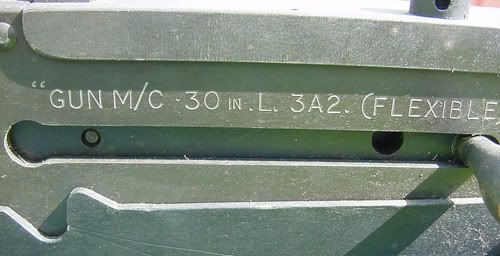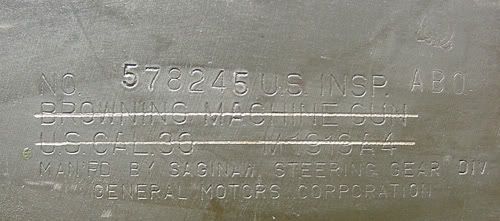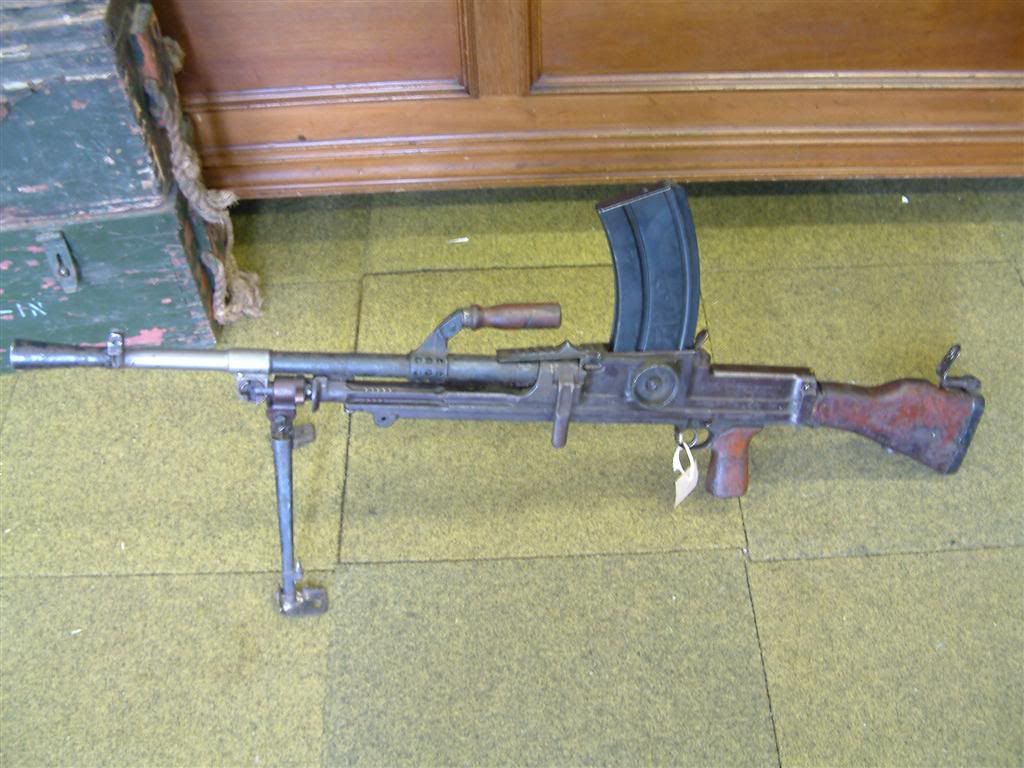
Chris Hall
-
Posts
1,410 -
Joined
-
Last visited
-
Days Won
14
Content Type
Profiles
Forums
Gallery
Blogs
Events
Articles
Store
Downloads
Posts posted by Chris Hall
-
-
Its just my guess, but I would expect that when the 1917A1 was used, the cork would be fitted to the steam outlet, and that the water in the jacket would just vent off, and if more water was required, fresh water would be poured in. My reasoning is that I doubt they would be continuously firing for long enough to burn all the water off, and that scalding hot water is somthing you dont want splashing around a jeep. The water chest for the 1917 has a big cap which is removed and the hose placed inside it, the water would soon be thrown clear if the Jeep was moving.
Do you have any photos of 1917s on Jeeps? They cant have been in use for long as the 1919A4 must have taken over very quickly.
-
I think this wa discussed on the forum in another thread when it all happened. Score 1 to the bobbies.
-
Kev, just replied to your thread on Milsurps, after seeing your Aussie mag I realised that they indeed do have dates (and I knew it) so ignore my last. The mag with the FTR mark is very nice, I've never seen a mag with such a good, clear marking.
-
How do you know its WW2 dated? I've never found one with a date.
-
I'm pretty sure that 1005-99-961-8393 is the NSN given to Australian refurbed .303 magazines. definatly not L4A1 mags as these are 1005-99-960-0089.
-
OM15 is still on the go...just. its being phased out and is supposed to be replaced with a oil called tellus I think. Its clear and its crap! A RAF Vap was taken to Norway and the oil froze. This stuff is going to be used on aircraft, I dont think so.
-
I went on Monday, I live about 400 yards away so had to go really. I managed to buy 4 NOS L4A1 Bren LMG mags for £14. I would have bought the rest if I had more spare cash on me. They usually go for £25 to £30 each so I was well chuffed.
-
The Browning i was issued with came with a Blue 58 pttn holster with a 37 pttn blue belt.
-
bin liner & stayed that way for ex duration.

H
I have one of those .30 cals, a British conversion to L3A2


-
A NSN Nation code of 17 would be Holland I Believe.
-
-
It shouldnt be a problem, the guidelines state that stocks are exempt from control (I think it actually states woodwork such as Stocks). Anything that is a nonpressure bearing part should be OK. I say should be, because every item is diffrent, i.e. A Sten sear, on a post 95 deac these are welded into place or removed, so importing one may be an offence, on a Bren its freely removable.
-
it just so happens i will be there! I'll be around to see you fix somthing.
-
Very nice, I'd say its for small arms, Bren/LMG, STEN/Sterling, Lee Enfield/SLR and the Enfield revolver/Browning. Can we see your complete one ferret fixer?
-
Heres one we rescued and used as a IED training aid in Iraq.

we set up permanent exhibits outside our accomodation to try and give examples of how IEDs or UXO may appear. It was open to anyone walking past to have a look, nothing was ever removed by a would be souvenir collector (Probably worried they were booby trapped).
-
Looks like some sort of test rig for F4 Phantom Jets.
-
The first use of the M16 family in British use (I think) was in Malaya in 1965ish. The units there received AR15 rifles, and one of the stories I heard was that they would go out on patrol and often either had one up the spout or had to cock their rifle many times. When the patrol was over, they would clear the rifle by cocking the round out and placing it back in the top of the mag. After repeating this dozens of times, the round would fire on cocking the rifle. It was found that due to the floating firing pin lightly tapping the percussion cap every time it was fed into the chamber, the indentation left on the percussion cap got deeper and deeper untill it set the round off. Quite a scary thought.
Going back to the actual question though, I have seen some photos of SAS and SBS in Oman in the 1970s with the A1 but I would think they mainly use the Diemarco C8 (M4 type) now.
-
Its a Bulgarian contract ZB39 in 8x56r (Hence the curved mag), the contract ended early due to the NAZI occupation, I cant remember if it was 300 or 3000 that were delivered before production ended. Which ever figure it was, there isn't many left. I have a original version and a post war communist cleansed version where the royal coat of arms has been removed.
Its also known as the commercial Bren as it wasn't produced by one of the UK arms factories (Its a Czeck BRNO made gun) but many parts are interchangable. Its such a nicely finished gun, its much higer quality than even the early Brens, but then again, the Enfield guns were made to government orders at a cost.
-
This is one of my rare Bulgarian machine guns, not to many of these around and its in better shape than it looks. I just need some time to clean her up.

-
Any chance of fitting Hispanos in the nose again?
-
Theres some wrecks at North Luffanham and the airfield is open for people to walk around. The F700s were burned years ago (They shouldn't have been) and the wrecks have been used for EOD training. Check it out on google maps.
-
Tim, I remember playing the cold war warrior miles away from everyone else very well. As the junior I always seamed to get nominated.
I spent some time at the old RAF Bowes Moor site clearing old mustard gas bombs. At wars end, they dug trenches, rolled the thin skinned bombs intothe ditches, covered with lime and then with a STEN, machine gunned them. The mustard gas then leaked out and reacted with the lime and cought fire. They then bull dozed the buildings (Brick work upto about 3-4 feet and then corrugated iron in a semi circular roof affair) into the ditches ontop of the remains. The modern day RAF decided they had better check for any undamaged bombs so we were tasked with re-digging the trenches and using mine detectors to retrieve what was left. Lots and lots of bricks! There was a permanent stench of bleach which I believe is a bi-product of the gas/lime reaction.
If anyone wants to have a look, go on google maps, look at the A66/A67 junction, there are some RAF buildings in the village, the main gate is now a farm just North on Clint lane and if you look north, north west of there you can see the bomb dump. I believe conventional weapons wern't supposed to be stored there however when my Sgt surveyed the area, they found a live 500LB bomb in a farmers barn. He had dragged it from the soil with his tractor many years earlier.
-
RVD, NIAD, NAPS, CAM. It brings back some memories.
-
I've not seen one before but I get the impression that its just like a bike bump.


Sten Mk2 return spring
in Weapons/Accessories
Posted
They cant be a section 5 part, its a spring. I've got 5 old spec STENs and the springs can be removed.